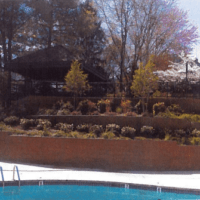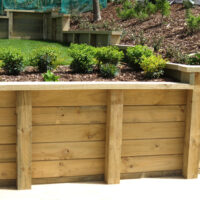Retaining Wall Material Guide

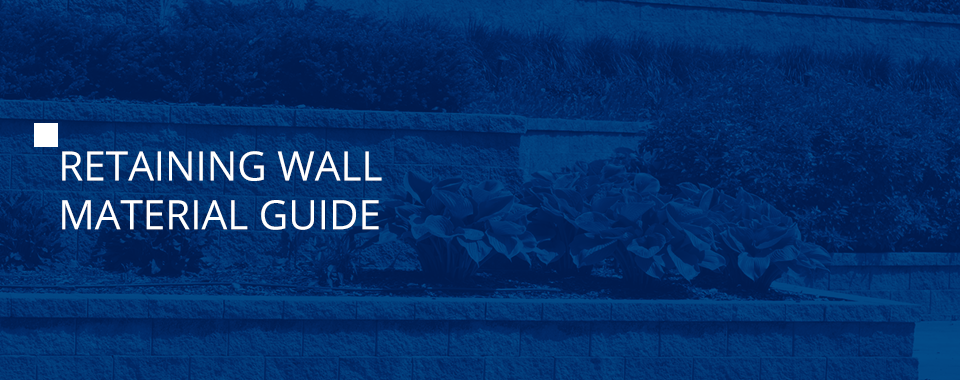
Retaining walls offer a mix of form and function. A retaining wall can hold back the soil behind it, playing an important role in preventing erosion, particularly on hills or in areas where plants can’t grow. Retaining walls are also used to create flat, usable ground on hilly terrain for things such as parking lots and sports fields. A retaining wall can also enhance landscape designs. For example, a landscape architect or designer might build retaining walls to create different levels of terrain or different elevations in a garden.
Retaining walls differ from the walls that hold up a building or another structure. While the walls of a home or apartment building are designed to support vertical loads such as ceilings and roofs, retaining walls are meant to support horizontal loads. For that reason, the design and engineering of a retaining wall differ from the design and engineering of the wall of a building.
While there are similarities in the types of materials used for building retaining walls and other types of walls, some materials are better suited for use with retaining walls. In this guide, we’ll take a look at some of the most commonly used materials for retaining walls.
Six Retaining Wall Materials
The type of material you choose for a retaining wall depends on your style preferences and the shape of the wall. The height and overall size of the wall also influence the type of material you can use. Materials also have a variety of price points and longevity.
Reviewing the pros and cons of each type of material will help you decide which one is best for your project.
1. Segmental Concrete Blocks
Segmental concrete blocks help to create a retaining wall that’s sleek and modern-looking. The blocks are often interlocking and are put together without the use of mortar. They are also available in a range of colors, from gray-stone to terracotta.
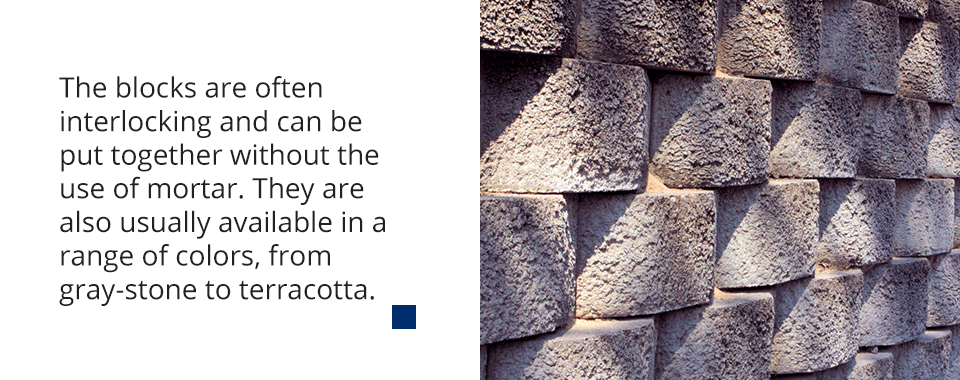
One of the advantages of using segmental concrete blocks to create a retaining wall is that the blocks are available in several different sizes. Blocks make it easy to build a curved wall. Different size blocks can be used to provide a natural stone aesthetic. Another advantage of using concrete blocks to build a wall is that it is a durable and low-maintenance material. It doesn’t need to be sealed or otherwise treated. For the most part, periodic cleaning is sufficient for keeping the wall looking great. With a bit of care and attention, a segmental concrete block retaining wall can last for many years.
However, concrete blocks have some potential drawbacks and aren’t always the best choice, depending on the project. In Resource Protection Areas (RPA), the local governmental jurisdiction may not permit the construction of a new segmental wall because it is considered an impervious surface. If you are interested in building a wall over a few feet tall with concrete blocks, it’s essential you work with a licensed structural engineer to design the wall and to ensure it is strong enough to provide adequate support.
2. Stone Veneer
A veneer is a thin layer of material placed to cover a supporting material. Some types of furniture have a wood veneer, meaning a paper-thin slice of wood is attached to a stronger base material, usually medium-density fibreboard (MDF). Retaining walls can occasionally have a stone veneer, meaning a protective, decorative layer of stone is applied over a sturdy but less aesthetically pleasing base. Often, the base material is made with concrete or concrete blocks.
A notable benefit of a stone veneer retaining wall is that it often costs considerably less than a wall made entirely of natural stone or masonry. With a stone veneer, you get the attractive look of stone without having to pay the high price.
Another advantage of using stone veneer for retaining walls is that it offers more flexibility when it comes to the design of the wall than other options. The base or core of the wall can be built to any height and can be built in a variety of shapes, including straight or curved.
3. Poured Concrete
Another way to create a concrete retaining wall is to pour the concrete in place, rather than use concrete blocks. Poured concrete often creates the strongest and most long-lasting retaining wall. Although many poured concrete walls are sleek and smooth, there is the option of utilizing specialty formwork to create texture or to replicate the look of stone or masonry. You can also attach a stone veneer to a poured concrete retaining wall for a more rustic look.
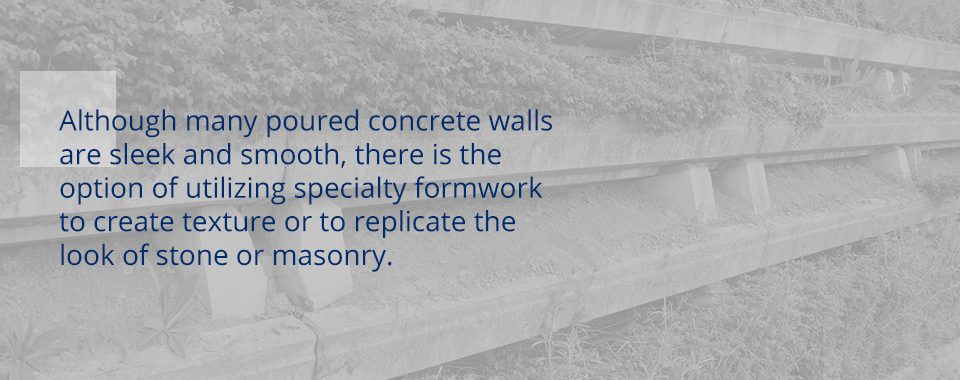
Creating a poured concrete retaining wall is not a job for amateurs or do-it-yourselfers. The wall needs to have a reinforced footing and a rebar support to keep it from failing. It’s important for poured concrete retaining walls to be designed and built by a professional, since poured concrete can be susceptible to cracks. While it is possible to repair small cracks with cement, larger cracks might make you wish you used a professional in the first place.
4. Brick
A brick retaining wall looks beautiful and can be strong and long-lasting. You have a couple of options when it comes to the construction of a brick retaining wall. The wall can be a cavity wall, meaning it is made from two or more layers of brick or concrete masonry with a cavity between them. The cavity between the two layers can either be filled with mortar or grout to form a collar joint or remain open with an integrated flashing system to manage entrapped water. Horizontal steel reinforcement is typically installed to properly connect the two layers of brick and provide additional support. Depending on the height of the wall it might need vertical steel reinforcement as well.
The other option is to create a core or base using concrete or concrete blocks, then adhere the brick to the front of the base. Less brick is needed when the wall has a concrete core, which can help to lower the overall cost. Using a thin brick veneer or half-width brick for the front of the wall can also help to keep costs down while maintaining the look and aesthetic of brick.
A brick retaining wall has a few advantages. Brick is long lasting. It’s not likely to be damaged by fire and can even help to slow the spread of fire in some cases. Brick walls are also relatively moisture-resistant.
One of the drawbacks of brick is that it can be heavy, meaning it is critical that the wall is installed with the appropriate amount of support. It can also be difficult to fix a brick wall if there is an issue with it. For example, replacing older damaged brick may be challenging, as it can be difficult to find a suitable brick match. The color of re-pointing mortar may also be difficult to replicate. Brick also tends to be more expensive than other materials, such as concrete.
5. Timber
A timber retaining wall is made from wood that typically measures six by six inches or six by eight inches. One of the benefits of using timber to build a retaining wall is that the material provides ample support. A timber wall is likely to be structurally sound. The wider width of timber helps to increase its service life. If you are going to use wood timber, your best option is to choose a treated wood.
Along with having a shorter lifespan compared to materials such as stone or brick, timber also has limited design choices. The size of the timber limits the design of the wall. For example, it can be difficult to create a curved wall from timber. If you’re interested in a long, straight retaining wall, timber can be a good pick.
6. Natural Stone
Natural stone retaining walls, sometimes known as dry stacked stone walls, are among the oldest types of retaining walls. The walls are built by stacking stones on top of each other. Natural stone creates a rustic look that is perfectly at home in a country or rural setting. The type of stone used to create the walls ranges from small rocks to large boulders.
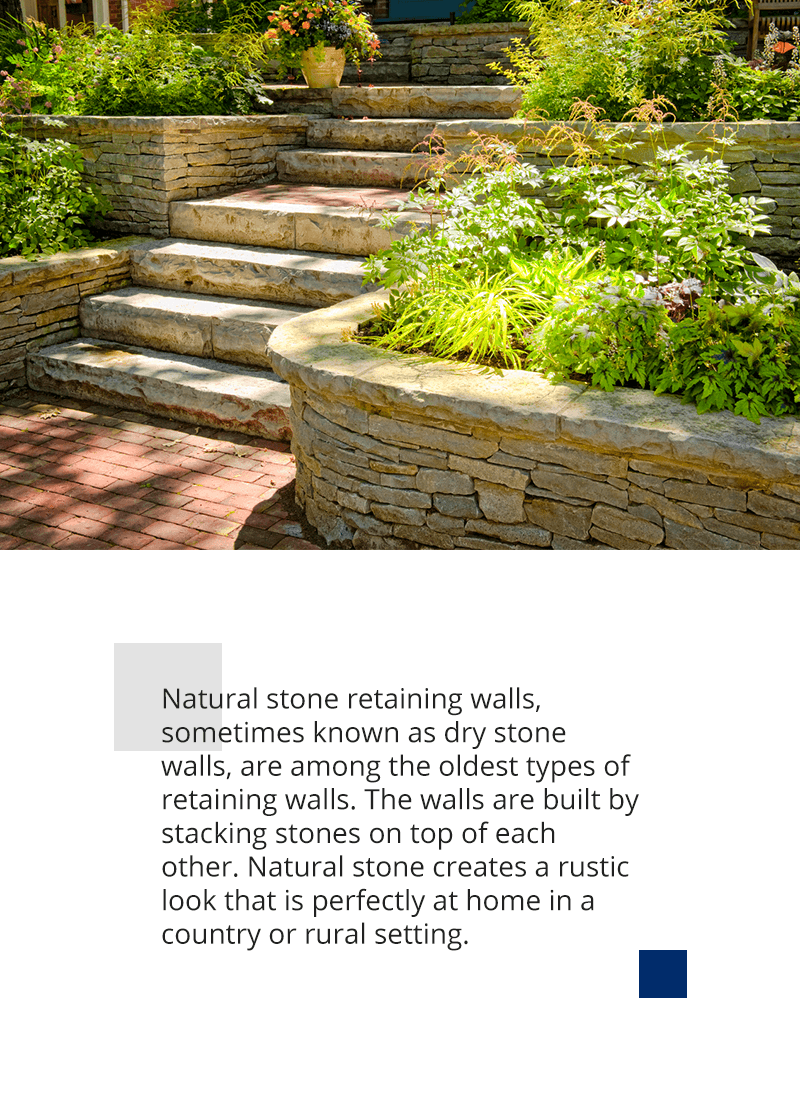
As it can be fairly challenging to build a long-lasting wall simply by stacking stones one on top of the other, the labor cost of a natural stone wall tends to be much higher than the cost of other types of retaining walls. The material cost also tends to be higher than other options, such as brick or wood.
Despite the higher cost, many people choose to install a natural stone wall because they believe the aesthetic appeal is worth it. Walls made with dry stone tend to bring to mind quaint cottages in the UK or other areas of natural beauty. The material works well for properties that want to draw attention to natural elements or in areas that are designed to be peaceful and relaxing.
Contact ETC to Learn More About Our Structural Engineering Services
When choosing a material, you should think about how long the retaining wall will last, your budget and the style of the property. You also want to make sure you work with a company that has experience and expertise when it comes to the construction of retaining walls. Building a retaining wall requires an understanding of structural engineering so that the wall is strong enough to hold back soil without collapsing. The taller the retaining wall, the more support and structure it needs. In addition, most retaining walls require an integrated below-grade drainage system to properly manage sub-surface water and prevent overloading from hydrostatic pressure.
If you’re interested in building a retaining wall at a property you own or manage, the first step is to find a reliable structural engineer to help you choose the best retaining wall material, design the wall and build it. The structural engineers at Engineering and Technical Consultants will work with you to help you choose the right materials for your retaining wall. We’ll also guide you through the design and construction of the wall. To learn more about the benefits of working with a structural engineer for your retaining wall project, contact ETC today.


